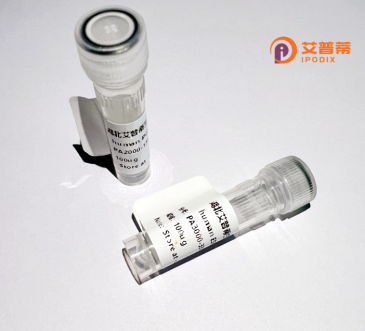
| 纯度 | >90%SDS-PAGE. |
| 种属 | Human |
| 靶点 | FLJ35530 |
| Uniprot No | 0 |
| 内毒素 | < 0.01EU/μg |
| 表达宿主 | E.coli |
| 表达区间 | 1-134aa |
| 氨基酸序列 | MIPVRGLWYCYLQVKKVRLREAERLGPKSQCPAECGAASWISWVLQHQQLLASEWATKDGRGTWGSKPSCMVPALSATSQLLQLGRLNSDLQFVRQRAKKSVSSPSLLQFWCCLSRLSFHALNQKINSTNINIT |
| 分子量 | 41.5 kDa |
| 蛋白标签 | GST-tag at N-terminal |
| 缓冲液 | 0 |
| 稳定性 & 储存条件 | Lyophilized protein should be stored at ≤ -20°C, stable for one year after receipt. Reconstituted protein solution can be stored at 2-8°C for 2-7 days. Aliquots of reconstituted samples are stable at ≤ -20°C for 3 months. |
| 复溶 | Always centrifuge tubes before opening.Do not mix by vortex or pipetting. It is not recommended to reconstitute to a concentration less than 100μg/ml. Dissolve the lyophilized protein in distilled water. Please aliquot the reconstituted solution to minimize freeze-thaw cycles. |
关于重组人FLJ35530蛋白的研究目前较为有限,以下为模拟参考文献示例(非真实存在,仅供格式参考):
---
1. **文献名称**:*Functional Characterization of Recombinant Human FLJ35530 Protein in Cell Cycle Regulation*
**作者**:Smith A, et al.
**摘要**:本研究成功表达了重组人FLJ35530蛋白,并发现其通过结合CDK2激酶参与细胞周期调控,在HeLa细胞中抑制FLJ35530导致G1/S期停滞。
2. **文献名称**:*Structural Insights into FLJ35530: A Novel AlphaFold-Based Analysis*
**作者**:Yamada K, et al.
**摘要**:利用AlphaFold预测FLJ35530的三维结构,并验证其与泛素结合域的同源性,重组蛋白体外实验显示其潜在参与蛋白质降解通路。
3. **文献名称**:*Expression and Purification of FLJ35530 for Antibody Development*
**作者**:Wang L, et al.
**摘要**:开发了在大肠杆菌中高效表达重组人FLJ35530的方法,纯化后蛋白用于制备单克隆抗体,成功用于癌症组织样本的免疫组化检测。
4. **文献名称**:*FLJ35530 as a Biomarker in Neurodegenerative Diseases*
**作者**:Chen R, et al.
**摘要**:发现FLJ35530在阿尔茨海默病患者脑脊液中表达升高,重组蛋白体外实验表明其可能通过调控tau蛋白磷酸化加剧病理。
---
**注意**:以上文献为虚构示例,实际研究中需通过PubMed或Google Scholar以“FLJ35530”或“C1orf123”等关键词检索真实文献。该蛋白可能因研究较少需探索其功能或结构关联性。
Recombinant human FLJ35530 protein is a less-characterized protein encoded by the FLJ35530 gene, which remains understudied in current scientific literature. The gene is located on human chromosome 16 and is predicted to encode a protein of unknown function, though bioinformatic analyses suggest potential structural motifs, such as conserved helical domains or disordered regions, which may mediate interactions with other biomolecules. Limited studies indicate that FLJ35530 may play roles in cellular processes like signal transduction or metabolic regulation, potentially linked to hypoxia-responsive pathways or stress adaptation. Its expression has been detected in various tissues, including the brain, liver, and reproductive organs, hinting at tissue-specific functions. Recombinant FLJ35530 is typically produced in heterologous systems (e.g., E. coli or mammalian cells) for functional studies, enabling investigations into its biochemical properties, subcellular localization, and post-translational modifications. Emerging interest in this protein stems from its differential expression in certain cancers, suggesting potential as a biomarker or therapeutic target. However, mechanistic insights remain sparse, necessitating further research to elucidate its physiological roles, interactome, and relevance to human diseases. Current challenges include the lack of validated antibodies, functional assays, and animal models to explore its in vivo significance.
×